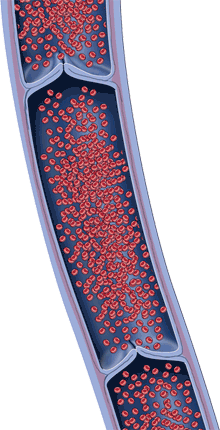Venous Insufficiency

WHAT IS IT?
There are a number of treatments available for varicose veins. These include oral medications for those people with aching and mild swelling of the legs, vein-focused oral medications may be an option to improve your symptoms. These anti-inflammatory medications work directly on your veins to ease symptoms. Dr. Andrew can discuss your options with you during your consultation.
Click on the links above to learn more or schedule a consultation with Dr. Andrew to discuss your vein concerns.
Venous insufficiency is a term that describes all the changes associated with vein disease. The changes range from telangiectasias and spider veins, to skin ulcers. Some of the skin findings with venous insufficiency are:
-
Telangiectasias: Fine red vessels on the skin, less than 1 mm in size
-
Spider veins: Blue/purple vessels on the skin, 1-3 mm in size
-
Varicose veins: Rope-like vessels that are especially visible when standing, greater than 3 mm in size
-
Hyperpigmentation: Skin darkening (brown) at the ankles, feet and lower leg
-
Dermatitis: Red itchy skin of the lower legs
-
Atrophie blanche: White star-shaped scars around the ankle
-
Lipodermatosclerosis: An episodic painful inflammation of the lower legs eventually causes the skin to harden.
-
Ulcers: Skin breakdown and wound formation, typically around the ankle
In addition to the skin changes, there are other symptoms of venous insufficiency. People will notice heavy legs, swelling, cramping or aching of the legs (especially at night), even tingling in the legs. These symptoms overlap a number of other conditions, so an ultrasound is an important tool to determine if there is a vein component to your symptoms.
In addition to the discomfort and appearance of the legs, venous insufficiency is also associated with developing a deep vein thrombosis, which is a clot in the deep veins of the leg that can travel to the lungs and cause a pulmonary embolism. A deep venous thrombosis can cause pain in the calf, swelling, or be completely without symptoms. A pulmonary embolism can also have a wide range of symptoms, from shortness of breath and chest pain to mild vague symptoms or none at all. Both deep venous thrombosis and pulmonary embolism can lead to death. Concern for these conditions should be considered in patients with venous insufficiency.
WHAT CAUSES LEG VEINS?

Normal vs. Abnormal

Unidirectional Flow
For a long time, the problem was thought to be due to gravity. Over time, the valves holding the blood in the veins would sequentially fail, leading to the disease descending down the leg from the groin. This descending theory of veins was only part of the story.
Today, we know that vein disease affects the vein wall itself. It can exist in multiple areas of the leg and even extend up the leg. This new understanding of venous insufficiency and varicose veins as an intrinsic disease has shifted our approach to treating and managing venous insufficiency.
With significant research still on-going with varicose veins and venous insufficiency, there are a multiple factors known to increase your risk of developing this problem. These include obesity, immobility, and pregnancy. Many factors cannot be changed, such as female gender, family history of vein disease, and aging.
The bright side is that treating your varicose veins and venous insufficiency has never been easier. In addition to stockings and anti-inflammatory medications, there are non-surgical procedures which can eliminate bothersome veins and improve venous circulation.
Most insurance plans cover these procedures. Recovery time is brief. Many people return to everyday activities the next day.